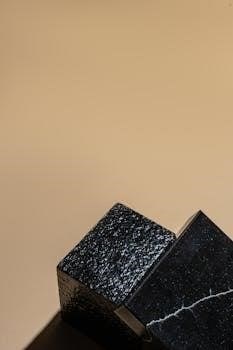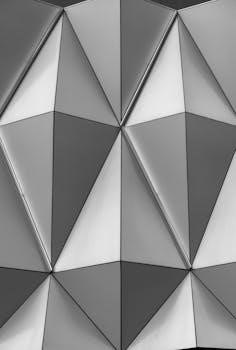Overview of 2D & 3D Shapes
This bundle covers both 2D and 3D shapes, including their individual properties. It is appropriate for students in Kindergarten, 1st Grade, and 2nd Grade. The resources include both 2D and 3D shape worksheets. It is a comprehensive tool.
Target Audience
These worksheets are primarily designed for students in Kindergarten, 1st Grade, and 2nd Grade. The activities help to solidify understanding of basic shapes, and their properties. The worksheets can be used for classroom activities, or homework.
Kindergarten, 1st Grade & 2nd Grade
For kindergarten, the focus is on introducing basic 2D shapes like circles, squares, triangles, and rectangles. Activities include tracing, coloring, and simple identification. First grade expands upon this by introducing more complex 2D shapes and basic 3D shapes like cubes and spheres. Second grade delves deeper into the properties of shapes, such as edges, vertices, and faces, alongside more complex 3D shapes. The worksheets cater to these developmental stages. Students learn shapes.

Content of Worksheets
The worksheets provide practice in identifying, drawing, and naming both 2D and 3D shapes. Students will trace shapes to improve fine motor skills. They will practice writing the names of different shapes. Worksheets are printable and digital.
Identifying Shapes
These worksheets provide a fun and engaging way for students to practice shape recognition. They will identify 2D shapes like circles, squares, triangles, rectangles, pentagons, hexagons, octagons, and trapezoids. The worksheets also include identifying 3D shapes, such as cubes, cones, spheres, cylinders, and pyramids. Students will learn to differentiate between 2-dimensional and 3-dimensional shapes, enhancing their geometry skills. There are activities which include mazes, matching 2D and 3D shapes, and sorting shapes. The worksheets provide a foundation for understanding basic geometry concepts.
Drawing Shapes
These drawing shapes worksheets offer a hands-on approach to learning geometry. Students will practice drawing various 2D shapes, including circles, triangles, squares, rectangles, and more complex shapes like pentagons and hexagons. Additionally, they will explore drawing 3D shapes such as cubes, cones, cylinders, and spheres. The worksheets help to develop fine motor skills while reinforcing shape recognition. By drawing shapes, students gain a deeper understanding of their properties and characteristics. This activity encourages creativity and provides a visual representation of geometric concepts, making learning more engaging and memorable;
Naming Shapes
Worksheets focusing on naming shapes enhance vocabulary and shape recognition skills. These activities prompt students to identify and write the names of various 2D shapes like circles, squares, triangles, rectangles, and hexagons. Similarly, they will learn to name 3D shapes, including cubes, cones, cylinders, and spheres. Through consistent practice, students solidify their understanding of shape names and improve their spelling abilities. These worksheets often incorporate visual cues and word banks to support learners. Naming shapes is a fundamental skill that builds a strong foundation for more advanced geometric concepts.
Activities Included
Engaging activities include tracing, sorting, and matching 2D and 3D shapes. These hands-on tasks solidify shape recognition. They will also help students develop fine motor skills. These activities are fun and interactive.
Tracing Shapes
Tracing shapes is a foundational activity that enhances fine motor skills and reinforces shape recognition. Worksheets often include dotted outlines of various 2D and 3D shapes. Children trace these lines, gradually improving their hand-eye coordination and muscle memory. This process helps them internalize the shape’s form, making it easier to draw and identify later on. Tracing also serves as a pre-writing exercise, preparing young learners for more complex writing tasks. It’s a simple yet effective way to build confidence and familiarity with geometric figures.
Sorting 2D and 3D Shapes
Sorting activities provide a hands-on approach to understanding the differences between 2D and 3D shapes. Worksheets may present a collection of shapes that students must categorize into two groups⁚ flat (2D) and solid (3D). This exercise encourages critical thinking and analytical skills as children analyze each shape’s properties. They must consider factors like depth, faces, and vertices to make accurate classifications. Sorting helps solidify the understanding of how 2D shapes form the basis of 3D objects, promoting a deeper comprehension of geometric concepts and spatial reasoning.
Matching 2D and 3D Shapes
These activities focus on connecting 2D representations to their corresponding 3D shapes. Worksheets often feature images of 2D shapes alongside a set of 3D shapes, requiring students to identify which 3D shape contains the given 2D shape as one of its faces. For example, matching a square to a cube or a circle to a sphere. This activity reinforces the concept of how 2D shapes are components of 3D objects, building spatial awareness and visualization skills. It challenges students to recognize shapes in different contexts and enhances their ability to relate geometric forms.

Shape Properties
Shape properties are the characteristics that define a shape. These include attributes like edges, vertices, and faces. Exploring these properties helps students differentiate and classify various 2D and 3D shapes based on their unique features.
Edges and Vertices
Edges are the lines where two faces of a 3D shape meet, or the sides of a 2D shape. Vertices (or vertex for singular) are the corners where edges meet. Understanding edges and vertices is crucial for identifying and differentiating between various shapes. Worksheets often include activities where students count the edges and vertices of different 2D and 3D shapes, solidifying their understanding of these fundamental geometric properties. This helps build a strong foundation for more complex geometry concepts later on.
Faces
Faces are the flat surfaces that make up a three-dimensional shape. Recognizing and counting the faces of 3D shapes is a key skill in early geometry education. Worksheets often feature activities where children identify the faces of shapes like cubes, prisms, and pyramids. Exercises may involve coloring the faces or matching shapes to the number of faces they possess. Understanding faces helps students visualize and differentiate between various 3D shapes, strengthening their spatial reasoning abilities and solidifying their understanding of geometric properties.
Worksheet Types
Worksheets come in both printable and digital formats, providing flexibility for different learning environments. Printable sheets are ideal for hands-on activities, while digital worksheets offer interactive engagement for modern learners.
Printable
Printable shape worksheets offer a tangible way for students to engage with 2D and 3D shapes. They can be easily incorporated into classroom activities or sent home as homework. These sheets often include activities like tracing, coloring, and cutting, which help reinforce shape recognition and fine motor skills. Printable worksheets are readily available, offering convenience for teachers and parents looking to supplement shape learning. Many options exist for creating custom worksheets or utilizing pre-made resources found online, ensuring accessibility for all.
Digital
Digital worksheets provide an interactive approach to learning 2D and 3D shapes. These resources are designed for use on computers and tablets, offering a dynamic learning experience. Digital worksheets often include interactive elements like drag-and-drop activities, fill-in-the-blanks, and virtual manipulatives. This format allows for immediate feedback and self-paced learning. The accessibility of digital worksheets makes them ideal for distance learning and technology-integrated classrooms. They can enhance engagement and cater to different learning styles through multimedia elements, creating a dynamic and engaging learning experience for students.
Uses
These worksheets are versatile, fitting seamlessly into classroom activities to reinforce learning. They can be assigned as homework to consolidate understanding. They are also valuable tools for distance learning, ensuring continued education outside of school.
Classroom Activities
Integrate these 2D and 3D shape worksheets into your daily classroom routine to boost engagement and understanding. These worksheets offer a practical, hands-on approach, enabling students to actively learn by identifying, drawing, and naming shapes. Use them during math centers, group work, or as individual practice to solidify geometric concepts. The activities are great for solidifying students’ understanding of shapes. Worksheets also allows students to work at their own pace. Incorporating these worksheets into classroom activities enhances geometrical comprehension.
Homework
Reinforce classroom learning by assigning these 2D and 3D shape worksheets as homework. These worksheets provide an opportunity for students to practice identifying, drawing, and naming shapes independently at home. This helps to consolidate their understanding of geometric concepts and reinforces their skills. The worksheets offer a convenient and effective way for parents to support their child’s learning outside of the classroom. Regular homework assignments using these worksheets can lead to improved retention and mastery of shape recognition and properties. This builds a solid foundation in geometry.
Distance Learning
These 2D and 3D shape worksheets are versatile for distance learning environments. They can be easily integrated into online platforms or sent home as individual sheets for remote learning. The worksheets provide a structured and engaging way for students to learn about shapes independently. Their design makes them suitable for various virtual learning setups. Teachers can assign these worksheets as digital activities or print them for students to complete offline. The worksheets enable students to practice identifying, drawing, and naming shapes, ensuring continuity in their geometry education. This is vital for distance learning.

Differentiation
Our 2D and 3D shape worksheets offer multiple levels of questions. This supports differentiation in the classroom. Worksheets cater to diverse learning needs. This ensures every student can engage with the material. It promotes effective learning.
Multiple Levels of Questions
Our worksheets include multiple levels of questions to cater to diverse learning needs. Level 1 focuses on identifying basic shapes. Level 2 involves comparing and analyzing shapes and their properties. Level 3 introduces more complex problems, such as shape composition and spatial reasoning. This tiered approach ensures that every student can access and engage with the material at their appropriate level. It promotes effective differentiation, allowing teachers to meet the individual needs of all learners, regardless of their current understanding of two- and three-dimensional shapes and geometry concepts.

Additional Resources
Supplement learning with shape posters for visual aids. Also, try shape card games for interactive practice. These resources reinforce shape identification. They also provide a fun and engaging way to learn geometry concepts beyond the worksheets.
Shape Posters
Enhance your classroom or home learning environment with visually appealing shape posters. These posters illustrate various 2D and 3D shapes. They can aid in memorization and recognition. Regular and irregular 2D shape posters are available. 3D shapes posters can also be found. They serve as a constant reference for students. Use them to support worksheet activities and reinforce shape identification skills. You can create your own or find printable options online. They are a fantastic visual aid for learning geometry.
Shape Card Games
Introduce an element of fun with shape card games. These games make learning interactive. They help reinforce shape recognition skills in an engaging manner. Card games can involve matching 2D and 3D shapes. They can involve identifying shapes based on their properties. Create your own set of cards, or find printable versions; These games are perfect for small group activities, or independent practice. Shape card games complement worksheet activities. They provide an alternative way for students to master geometry concepts. They are an excellent resource for teachers and parents.

